Let’s get one thing straight — eating “real Thai food” doesn’t mean having pad Thai on Khao San Road while sipping a Chang and saying “sawasdee kha” to the waiter. Respect the effort, but that’s just the tourist starter pack.
The truth is, most travelers never scratch the surface of Thailand’s culinary weirdness — and I mean that lovingly. This country is a foodie jungle of regional dishes, fermented surprises, and questionable protein choices. Some are delicious. Some are… educational. And some might just test your relationship with your digestive system.
Today we’re going beyond the pad Thais and penang curries and into the world of raw beef, ant egg stew, and dishes that don’t make the travel blogs. I’ve even thrown in a few personal stories for good measure. You’re welcome.
🦂 But First, About Those Scorpions on Khao San Road…
You’ve seen them — those jet-black scorpions, lined up on sticks under heat lamps like insect kebabs. Every backpacker’s dare, every YouTuber’s thumbnail.
But here’s the thing: Thais don’t really eat scorpions.
At least, not like that. The truth is, they’re mostly for tourists. A novelty snack. A bragging-rights-on-Instagram kind of thing. Yes, some Thais in certain regions might eat them, but it’s rare. Not unheard of — but it’s no one’s comfort food.
And how do they taste?
I tried one my first week in Thailand. It tasted like… nothing. Just crispy, empty, slightly burnt chitin. Like fried fingernails. Not offensive, just… pointless.
So yeah — if your goal is “eat what the locals eat,” you can skip the scorpion-on-a-stick. You’re not missing anything.
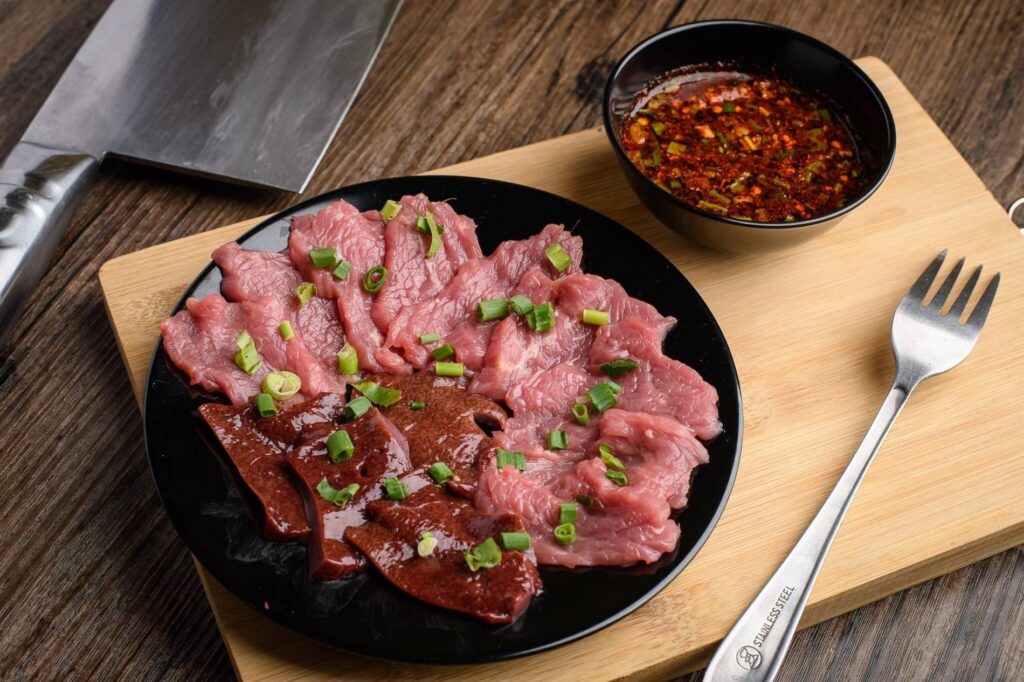
🐜 Isaan (Northeast Thailand): Fire, Funk, and the Unexpected
Isaan cuisine is bold, spicy, and occasionally raw. It’s my home region, and trust me, it never disappoints — or fails to surprise.
1. Soi Ju (ซอยจุ๊)
Raw beef salad with chili, herbs, and sometimes raw liver or bile. I actually enjoy this dish — but pro tip: it’s meant to be shared.
The first time I had it, I thought, “Ooh, steak tartare, Thai-style!” and polished off the entire portion by myself. Rookie mistake. Let’s just say I spent the next morning very reflective — and very close to the toilet.
2. Ant Egg Soup (แกงไข่มดแดง)
This one comes with a story. When I first visited my girlfriend’s mum in rural Loei, she pulled out all the stops — a full-on welcome feast.
There was gaprao, som tam Laos, fried rice — and one bowl of what looked like rice soup. It tasted fine, a bit bland, kind of nutty. I asked what it was.
Turns out it was ant egg stew, a local delicacy reserved for special occasions.
On closer inspection, I could see little ants floating in it — which I’d initially mistaken for herbs.
I finished it (because manners), but now I always ask what’s in the bowl before diving in.
3. Larb Leuat Neua (ลาบเลือดเนื้อ)
Think larb, but with raw beef and fresh cow blood. Locals love it. Me? I need to psych myself up for that one.

🐃 Northern Thailand: Earthy Flavors, Fermented Feels
1. Aep (แอ็บ)
A Northern specialty — banana-leaf parcels stuffed with herby pork, fish, or offal (and sometimes blood), grilled over charcoal. Delicious if you’re into herbal sausage-y things.
2. Khanom Jeen Nam Ngiao (ขนมจีนน้ำเงี้ยว)
A pungent tomato-based noodle soup with pork blood and fermented soy. Tastes better than it sounds — but not always a hit with sensitive noses.
3. Dtong Nuea (ต๋องเนื้อ) – Fermented Raw Beef With Herbs and Bile
This dish is not for beginners.
Dtong Nuea is raw beef that’s been fermented, mixed with local herbs, spices, and sometimes a splash of bile (yes, the bitter stuff from a cow’s gallbladder) for that extra je ne sais quoi — or rather, je sais exactement quoi and it’s intense.
It’s often eaten with sticky rice, raw vegetables, and a side of bravery. The smell alone can make a grown man reconsider his life choices. But locals swear by it, especially older generations in rural Northern provinces like Chiang Rai or Phayao. Some even believe it boosts strength and virility.
Would I eat it again? Let’s just say it’s a “know your limits” kind of dish.
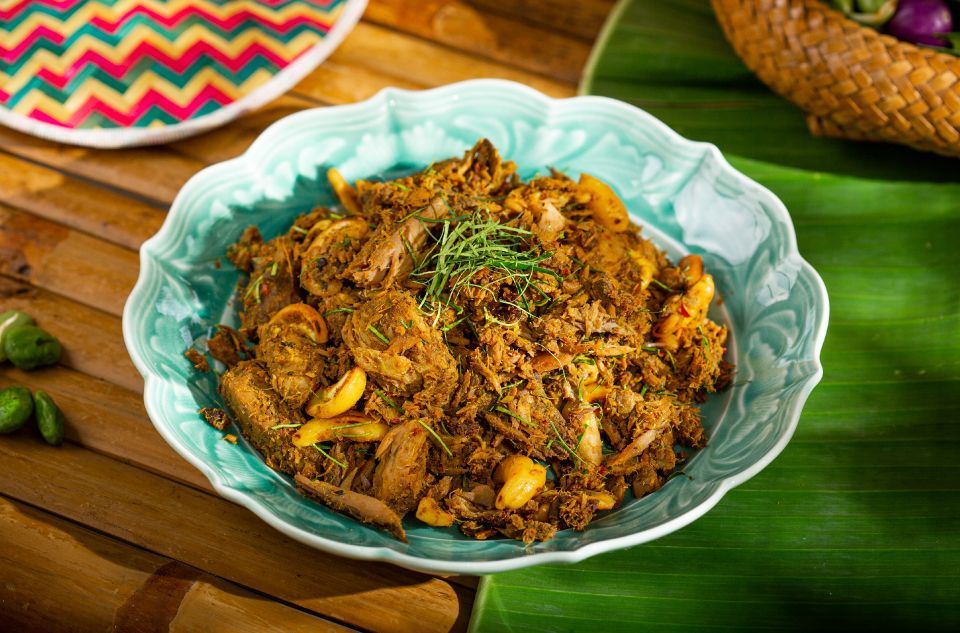
🦑 Southern Thailand: Seafood, Spice, and Fermentation on Steroids
1. Gaeng Tai Pla (แกงไตปลา)
A fiery curry made with fermented fish guts. The smell could kill mosquitoes, but locals swear by it. If you like bold, salty, funky dishes — this is your Everest.
2. Sataw Pad Kapi (สะตอผัดกะปิ)
Stir-fried stink beans with shrimp paste. Smells like it was cooked in a gym bag — tastes weirdly addictive. Pairs well with rice and a strong stomach.
3. Gaeng Luk Yi (แกงลูกหยี) – Spicy Curry with Indian Tamarind Seeds and Bee Larvae
This rare southern dish combines the sharp, fruity sourness of Luk Yi (Indian tamarind seeds) with the creamy richness of bee larvae — yep, actual baby bees. The curry is spicy, complex, and surprisingly rich thanks to the larvae, which melt slightly when cooked, giving the broth an oily, nutty depth.
It’s a dish that sounds like a punishment but tastes like a reward… if you’re brave enough to try it. It’s usually homemade or served in tiny village restaurants — not something you’ll find at a Phuket beach resort buffet.
Perfectly weird. Perfectly Southern.
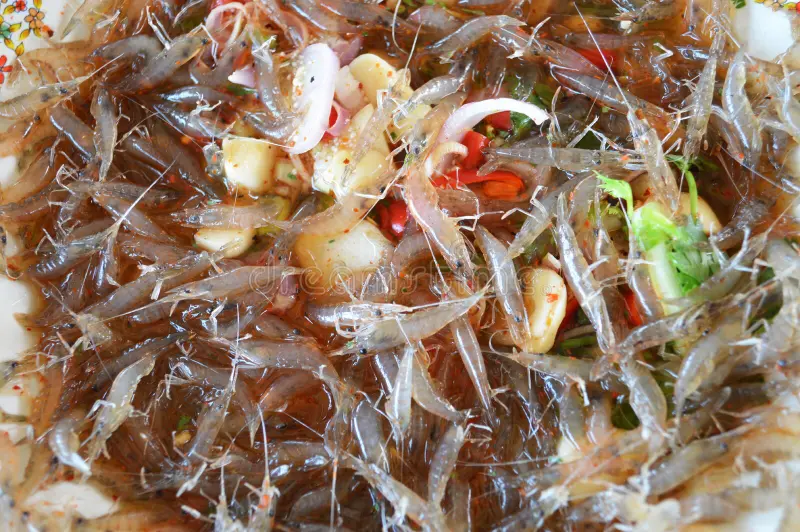
🍲 Central Thailand: Comfort Food With a Side of Surprise
1. Goong Ten (กุ้งเต้น)
“Dancing shrimp.” They’re raw. They’re alive. They’re dressed in lime and chili. And they are definitely still moving.
It’s like your food is trying to escape while you’re eating it. A bit intense for date night, but very memorable.
2. Khao Khluk Kapi (ข้าวคลุกกะปิ)
Rice mixed with fermented shrimp paste. A little funky, a little sweet, and topped with egg, mango, and pork. It’s actually delicious once you get over the smell.
3. Lun Puu Kem (หลนปูเค็ม) – Fermented Salted Crab Coconut Dip
Lun is a creamy, coconut-based dip usually eaten with fresh vegetables and sticky rice. It sounds innocent — until you realize this version is made with fermented salted crab (shells, legs, and all), mashed into a funky, briny paste and simmered in coconut milk with chilies, lemongrass, and shallots.
The result? A bizarrely addictive combination of creamy, salty, and fermented-funky. You scoop it up with raw eggplant or cucumber, and it either blows your mind or makes you check the expiry date — there’s no in-between.
Locals love it. Most expats… aren’t sure what just happened to their taste buds.
Real question: Would you rather eat a spoonful of ant eggs or a bowl of fermented fish curry? Or are you more of a “pad Thai only” kind of adventurer?
Final Thoughts: Curiosity (Usually) Beats Comfort
The wild thing about Thailand is that almost everything is edible — at least to someone. Water monitor lizards? Yep, some people eat those. Frogs? Definitely. Eels? Daily special. If it moves, there’s probably a recipe for it somewhere in the country. Actually, I remember walking in my wife’s village and seeing a man who was cooking something interesting at the back of his house. Interested, I asked him what it was. He said he had just comeback from hunting in the jungles of Phu Luang. He had caught a juicy flying squirrel and was now barbequing it for the family. I asked to try, but he said, with a smile, it’s not cooked yet. I sensed it might have been a polite way of saying ‘this is for my family and there isn’t much meat on it!’, so I smiled, gave him a mai bpen rai, thanked him and carried on with my walk.
And while some dishes may never make it into your weekly meal plan, trying them at least once opens a window into Thai culture that no tourist trail ever could.
So, next time you’re offered something unfamiliar, don’t just poke it with a spoon. Ask what it is, smile, and if you’re feeling brave — give it a go. Or at least pretend to, then quietly pass it to someone else.
What’s the weirdest thing you’ve eaten in Thailand? Would you try raw beef larb? Ant eggs? A dancing shrimp?
Drop a comment, shoot me a message, or come over and I’ll cook you something strange. You might love it. You might cry. Either way, it’ll be a story.
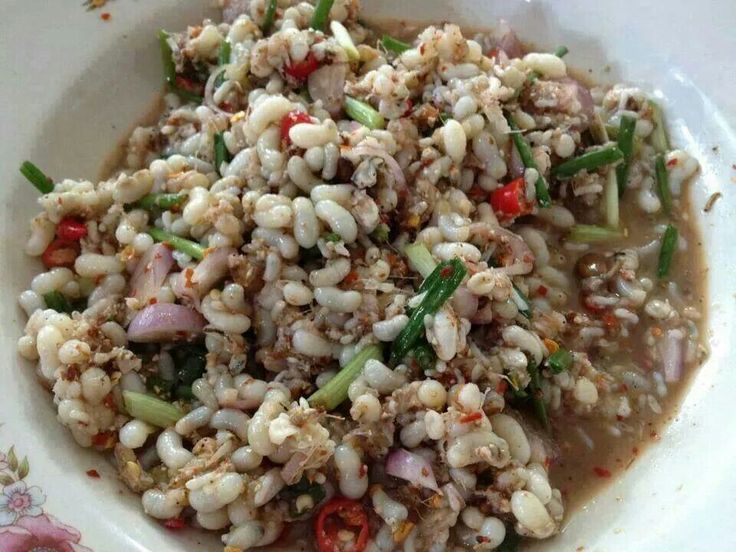

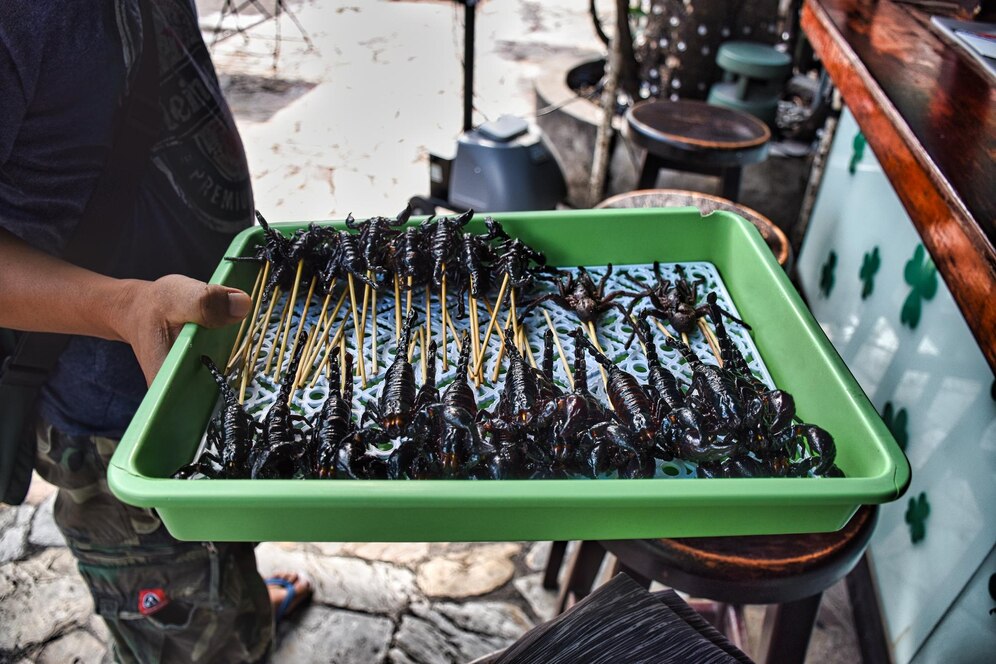

Not sure if I’d try any of these. I’ll stick to pad Thai!
Vic88vingroup, I’m intrigued. You a big player? Gonna give your site a try. Live casino games better be on point! vic88vingroup
Right then, 89kbetvn. Decent site for a punt. Nothing overly spectacular, but it does the job. If you fancy a quick flutter, why not? Check it out: 89kbetvn
Interesting article! Seeing how quickly platforms like jili56 game are evolving-fast access & data insights are key now. It’s not just about luck, but learning patterns! Definitely changing the game.